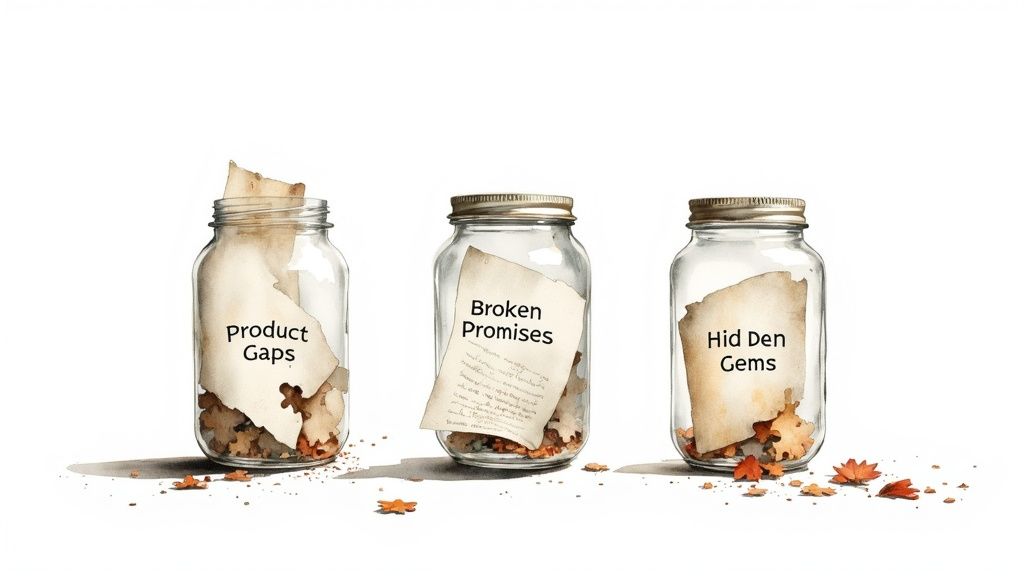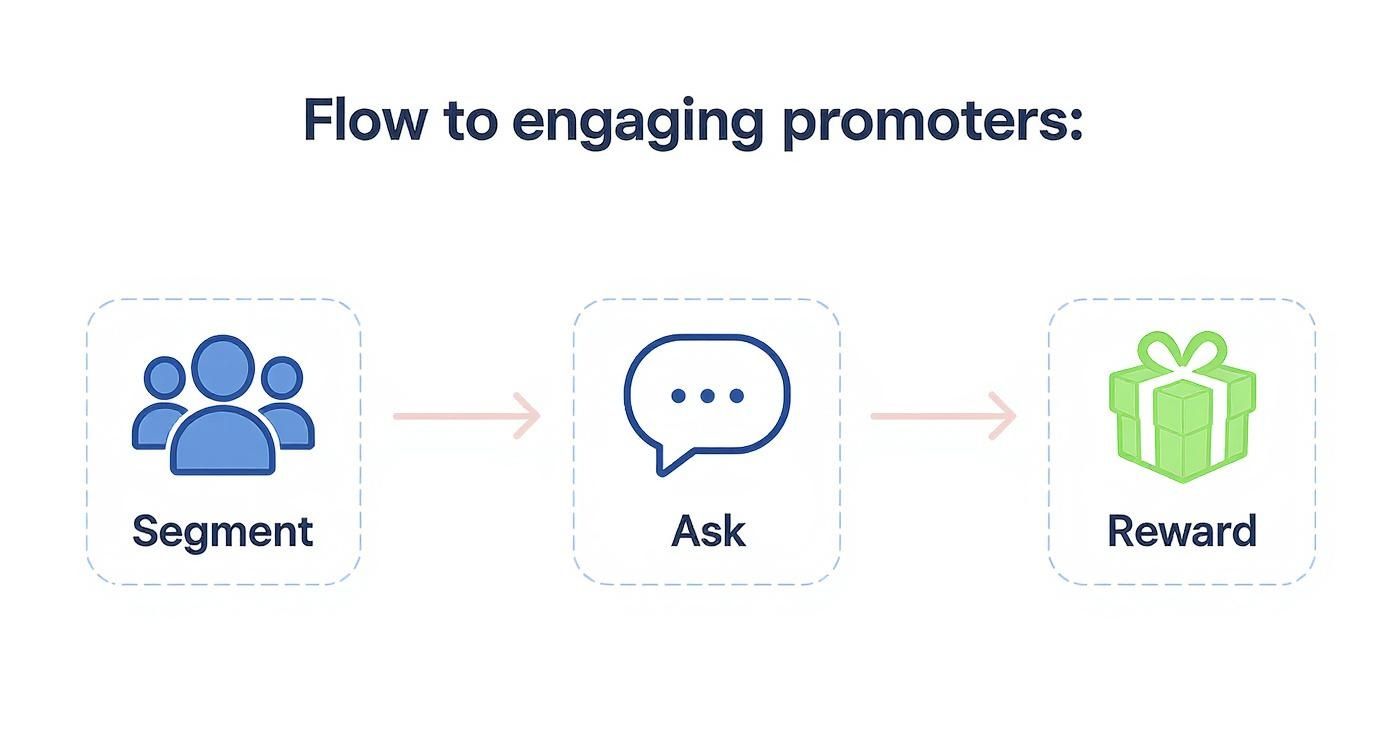Your NPS Score Is a Useless Vanity Metric (And Here's What to Track Instead)
Stop chasing a vanity metric. Learn how to improve NPS scores by focusing on the raw feedback that actually drives revenue and cuts churn. A founder's guide.
Posted by
Related reading
Customer Advisory Board: The Founder's Playbook for Avoiding Catastrophic Mistakes
A practical guide to building a customer advisory board that provides honest insights, validates your strategy, and prevents costly product mistakes.
Why Reputation Management Tools Matter More in 2025 Than Ever
Learn how reputation management tools help businesses track reviews, analyze feedback, and protect brand image. A modern guide with AI-driven insights using Backsy.
Sentiment Analysis Isn’t a “Nice-to-Have”. It’s a Lie Detector for Your Product.
Founders love chasing features, but customers speak in emotions. Learn what sentiment analysis really is, how it works, and how it reveals the truth behind your feedback. No fluff.
Your NPS score is a drug. It feels good to see it go up, and it’s a convenient number to slap on a slide for your board. But let’s be honest: you’re addicted to a vanity metric, and it’s making you stupid.
I once watched our NPS climb for two straight quarters right before a massive, unexpected churn event blew a hole in our revenue. The score lied. It told me everyone was happy, while our best customers were quietly packing their bags.
The score is a ghost. It’s a lagging indicator of a feeling a customer had weeks ago. By the time that number dips, the damage is done, the customer is gone, and you’re left wondering what the hell happened.
This isn’t another fluffy guide on how to game a metric. This is a detox program. We’re going to stop chasing the score and start digging for the gold buried in the only thing that actually matters: the raw, unfiltered, and often brutal comments your customers leave behind.
Ignore your customers, and you’ll be lucky to survive the quarter.
Step 1: Stop Admiring the Compass and Start Reading the Damn Map
Think of your NPS survey like this: the 0-10 score is a compass. It gives you a vague direction—good, bad, whatever. But that little open-ended text box? That’s the treasure map. It’s covered in X’s marking the exact location of your product gaps, broken promises, and hidden opportunities.
Most founders just stare at the compass, patting themselves on the back when it nudges north. This is moronic. Chasing the score leads to pathetic, value-destroying behaviors like:
- Begging for 10s: Pestering happy customers just to move a meaningless number.
- Ignoring the 'why': Celebrating a jump from 40 to 45 without a clue what actually caused it.
- Fixating on Passives: Wasting energy trying to nudge 8s into 9s instead of fixing the glaring issues making your 2s furious.
This isn't just about feelings; it’s about cash. Companies that lead in NPS grow at two to three times the rate of their competitors. A tiny 7-point NPS increase correlates to a 1% bump in revenue growth. Your score is a byproduct of fixing real problems, not the goal itself. Stop reporting the number in your all-hands. Start showing the most brutal customer comments on a slide instead.
Takeaway: Stop admiring your compass and start digging where the map tells you to.
Step 2: Triage Feedback Like a Field Medic, Not a Librarian

Forget fancy sentiment analysis charts. They’re corporate theater designed to make VPs feel busy. In the trenches, you need a brutally simple system for triage. Every piece of feedback—from NPS comments, support tickets, or angry tweets—fits into one of three buckets. That’s it.
Bucket 1: Product Gaps
These are the missing features and clumsy workflows your customers are screaming for. The trap? Building everything they ask for. That’s how you get a bloated, confusing product nobody loves. Filter these requests with one question: "How much revenue is trapped behind this missing feature?" A $50k/year client asking for an API endpoint? That’s a priority. A freemium user demanding a niche button? Into the void it goes.
Bucket 2: Broken Promises
This is the most dangerous bucket. A Broken Promise is any gap between what your marketing screams and what your product actually delivers. These are churn bombs waiting to go off. We once promised a "5-minute integration." In reality, for some stacks, it was a 45-minute nightmare. Our NPS comments were vicious. 12% churn in the first 30 days. We didn't build a new feature. We fixed the onboarding and changed the copy to "under 15 minutes." Churn dropped to 4% in a quarter. We just aligned the promise with reality. This is the real voice of customer meaning; it’s about the expectation you set.
Bucket 3: Hidden Gems
This is where your next market is hiding. Hidden Gems are the unexpected, off-label ways customers use your product. We had a user jerry-rigging our B2B feedback tool to collect testimonials for a book launch. Weird, right? We dismissed it as an edge case. Big mistake. That single insight led to a new landing page and feature set that now accounts for nearly 20% of our new sign-ups. These users are beta-testing new verticals for you, for free. Don't ignore them.
Takeaway: Stop cataloging feedback and start sorting it into buckets that force you to act.
Step 3: Turn Your Haters Into Your Unpaid Product Team

Your Detractors—the ones giving you a 0 or a 1—are not a PR crisis. They are your most valuable, unpaid R&D source. They’re giving you a passionate, detailed bug report on your entire business. Stop treating them like the enemy and start treating them like a consultant you’re not paying for.
When a Detractor unloads on you, the clock starts ticking. I send a personal email from my own account within 24 hours. No automation. No corporate-speak. Just this:
"You're right, we screwed up on X. Your feedback was blunt, and I appreciate that. I’m the founder, and this is on me. Can you spare 15 minutes to show me exactly where we failed you? No sales pitch, I just want to listen."
This script validates their anger, shows extreme ownership, and makes a tiny ask. It works. But getting the feedback is only half the job. The real leverage comes when you close the loop. Weeks or months later, when you ship the fix they inspired, you email them again:
"Hey [Name], remember that issue you flagged? We just shipped the fix. You were right. Thank you."
I once had a customer who was furious about a billing error become our best case study and refer three new enterprise clients after we did this. He went from threatening to sue us to being our unpaid salesperson. This isn't rocket science. It's just giving a damn. Your Detractors are handing you a prioritized list of churn risks; use it before you need one of those complex feature prioritization frameworks.
Takeaway: Your loudest critics are handing you a roadmap to save your company; have the guts to listen.
Step 4: Stop Asking Promoters for Reviews (It’s Lazy)
That automated email begging Promoters for a G2 review? It’s the laziest move in the founder’s playbook. You're treating your biggest fans like marketing pawns. Stop. A Promoter is an asset, and you're wasting it on a generic five-star rating.
Before you ask for anything, segment them. Brutally. A VP of Engineering at a Fortune 500 and a founder at a 10-person startup are not the same. They have different networks, different problems, and different value to you. Don't send them the same pathetic "share on social" request.
Once you know who they are, make a specific, high-value ask.
- To the technical user: "We're building a new API and I know you'd have strong opinions. Got 30 minutes to tear our prototype apart? I want your most brutal feedback."
- To the well-connected exec: "We're trying to crack the logistics space. Do you know one or two people I could talk to for 15 minutes, just to understand the landscape?"
- To the power user: "You've used Feature X more than anyone. We're about to kill it or rebuild it. What would you miss if it were gone tomorrow?"
See the difference? You’re not asking for a favor; you're inviting them to be a co-conspirator. You’re making them an insider. And for God's sake, don't reward them with a $10 Starbucks card. It's an insult. Give them early access, exclusive swag, or a handwritten note from you. This turns happy customers into an unpaid extension of your sales and product teams. It's far more potent than any generic user-generated content marketing campaign.
Takeaway: Stop treating Promoters like a resource to be milked and start treating them like partners.
Step 5: Install a Weekly Rhythm That Forces Action
Your customer feedback is worthless until you act on it. Vague intentions to "listen to customers" are a fast path to bankruptcy. You need a rhythm—a non-negotiable weekly cadence that forces accountability.
Carve out 60 minutes. Every week. No exceptions. Get product, engineering, and marketing leads in a room. This isn't a coffee chat. It's a high-stakes meeting with a strict, action-oriented agenda.
| Time Allotment | Agenda Item | Goal & Owner |
|---|---|---|
| 15 mins | Top 3 Themes | Owner presents the critical patterns from your Product Gaps, Broken Promises, and Hidden Gems buckets. No reading comments aloud. |
| 20 mins | Triage, Assign, Deadline | For each theme: bug, feature, or knowledge gap? Assign an owner. Set a hard deadline. Nothing leaves without a name and a date. |
| 15 mins | Close the Loop Check-In | Status check on last week's fixes. Who did we talk to? What did we learn? Who can we tap for a case study? |
| 10 mins | Commit to Ship One Thing | Commit to one customer-driven micro-improvement to ship before the next meeting. A tiny win to build momentum. |
This structure forces you to stop admiring the problem and start shipping solutions. It creates relentless, customer-driven progress. The goal isn’t just to talk; it’s to ship.

This isn't theory. Industries that get this right see massive gains. Healthcare and Ecommerce NPS scores jumped 5 to 7 points recently because they were forced to adapt their digital experience faster than expected, a trend you can see in these NPS benchmark findings. Your weekly meeting is the engine that drives that adaptation. Other customer satisfaction metrics are just as useless without a system for action.
Takeaway: You don't need more data; you need a weekly execution cadence that turns feedback into revenue.
The Only Metric That Actually Matters
After all this, it comes down to one thing. It's not your NPS score. It's an internal metric you probably aren't even tracking: Time to Action.
How many hours pass between a customer submitting feedback and a ticket landing in Jira? How quickly does a Detractor’s comment get a personal follow-up from a founder? If your Time to Action is measured in weeks, you’re already dead. You just don't know it yet.
A competitor can copy your features and undercut your price. They can't easily replicate a culture that acts on feedback with obsessive, fanatical urgency. Your NPS score is a report card on your past. Your Time to Action is a predictor of your future revenue. It's how you boost things that matter, like your understanding the Customer Lifetime Value (CLV) formula.
So stop staring in the rearview mirror. Plaster your Time to Action on a dashboard for the whole company to see. The faster you close the loop between feedback and action, the faster everything else—revenue, retention, and yes, even that damn NPS score—will grow.
Takeaway: The speed of your feedback loop is the single greatest predictor of your company's success.
Stop guessing what customers want and start building what they're begging for by analyzing their feedback in minutes with Backsy.ai.